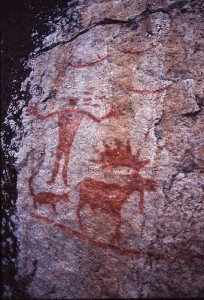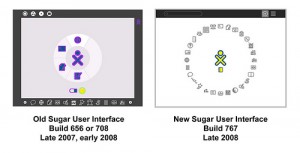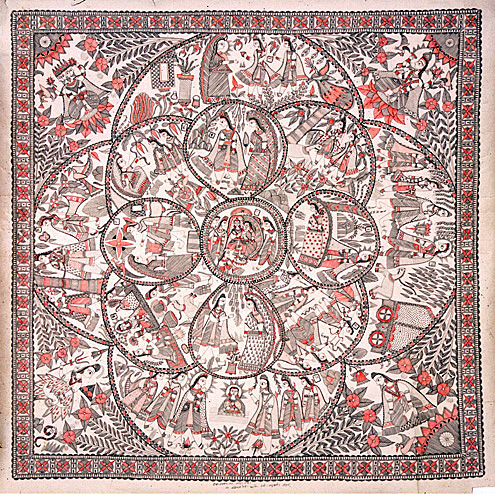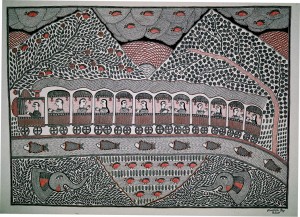Hello Everyone,
My research paper comparing the codex with the development of TV can be found in the course wiki here. Feel free to leave comments.
Cheers
Drew
Hello Everyone,
My research paper comparing the codex with the development of TV can be found in the course wiki here. Feel free to leave comments.
Cheers
Drew

Hello my virtual friends.Please visit this link to read my research paper on punctuation
Take care
Dilip
The dawn of the printing press not only changed the realm of writing, it also fostered a crucial change in human thought process and learning. The evolution of the written word into a mass-produced, evenly distributed visual work promoted a cultural shift from oral to visual dominance. Walter Ong provides important insights on the cultural shift and provides thorough examples to validate it. However he falls short of providing an adequate theory for the physiological changes within the human brain. This does not necessitate that he is incorrect, but rather that more information could be provided. The visual shift occurring in our culture has not always been met with enthusiasm. In fact, there is a form of backlash against the visual stating that it cultivates a lack of intelligence. Ong’s central message indicates a move from the oral to visual realm. Yet it can also be theorized that the shift is actually a return back to the visual. The theory we accept is minor in comparison to the interchange of the two realms, which will provide major implications for western culture and self-consciousness.
The printing press is the technological advancement that ushered in the cultural swing of oral to visual. Ong argues that the letterpress situates words in space and locks them in place forming a visually appealing work. The printing press also allowed access to works en masse and was structured in a manor more easily read than that of manuscripts written by hand. Marshall McLuhan (1962) suggests that a technology, such as the printing press, creates changes in our thoughts and expressions. In other words, the new technology changes our consciousness. Ong (1982) uses numerous examples as evidence for the advancement of the visual cultural shift theory. The creation of lists, indexes, and even our own axioms indicate our move from oral to visual. Ong’s references to different cultures and examples are extensive and confirm that a shift had occurred, but Ong lacks physiological evidence as to why a change had taken place in human consciousness.
The human brain is divided into two sides, the left and the right. Studies of patients with split brain provide us with insights into how the brain works. Their findings suggest that the left portion of the brain is responsible for speech, abstract thinking, logic, and numeracy. The right portion of the brain deals with spatial recognition and facial recognition, suggesting that the right portion of the brain is more visually oriented. Leonard Shlain confirms this theory in his book the “Alphabet Versus the Goddess: The Conflict Between Word and Image”: “The right brain is nonverbal. … It comprehends the language of cries, gestures, grimaces, cuddling, sucking, touching, and body stance. Its emotional states are under little volitional control and betray true feelings through fidgeting, blushing, or smirking.” (Shlain, 1998, 18-19). Malcolm Gladwell’s book “Blink”, argues that cognition based on the visual is faster and more accurate than cognition influenced by words or logic (Gladwell, 2007). Therefore, the rapid change in our culture due to new technologies could cause us to use the rapid, more accurate side of the brain for processing new information. The theory suggested here has fascinating implications particularly for the fast paced world of the 21st century. Our reliance on visual images could be due to our need to get information at a more rapid pace.
Visual perception may be a more powerful tool for incorporating information than oral. The New Encyclopedia website further demonstrates a visual dominance due to the fact that visual perception is multi-channeled, whereas auditory perceptions are mono-channeled. “The eye can absorb that many different things at once without confusion or overload, but the ear’s inability to take in multiple soundtracks — multiple dialogues — at the same time is further evidence of the greater power of visual perception compared with perception of aural (word-based) communication” (New Encyclopedia, 2008). The invention of the printing press created a basis for visual uniformity causing the shift in a need for multichannel communication.
As Ong suggests, culture and perception have shifted from orality to the visual. However, Ong provides numerous examples of intellectuals who revolted against the use of writing, but no examples of those who revolt against the cultural shift from auditory to visual dominance. Lester Faigley, professor of English at the University of Texas, provides some of the major criticisms of the visual shift in his keynote speech presented at the Center for Interdisciplinary Studies of Writing (1998 Conference) entitled “Technology and Literacy in a Wired Academy”. He attests that many scholars are researching the thoughts of images encroaching on written territory: “Barbara Maria Stafford has examined how current attitudes toward images were formed in eighteenth-century England, when educated people began associating images with ignorance, illiteracy, and deceit” (Faigley, 1998, pg. 4). Images were also seen as creating a loss of intellect. This can be seen in Williams Wordsworth’s poem, “Illustrated books and Newspapers”, in which he stated new technologies creating images that foster a lack of intelligence and a move backwards instead of forwards in intellectual discovery. Wordsworth indicates his apprehension of image based culture while trying to hold onto the auditory traditions:
“Back towards caverned life’s first rude career.
Avaunt this vile abuse of pictured page!
Must eyes be all in all, the tongue and ear
Nothing? Heaven keep us from a lower stage!” (Wordsworth)
Could the shift from oral to visual perception be a return to the visual? Ong (1982) suggests that the change occurs but does not necessarily reference whether the shift is a return to the visual or a new conceptual change. Harold Innis suggests that it could be a return to the visual. “the discovery of printing in the middle of the fifteenth century implied the beginning of a return to a type of civilization dominated by the eye rather than the ear” (Innis, 1951, p. 72). It is true that before written text many visuals were used in order to indicate meaning. Different cultures have used picture images to facilitate communication. However, in western culture, it is clear that manuscripts contained visual images as well as text, suggesting perhaps that the shift was from visual to oral and back to visual. The New Encyclopedia’s section on visual culture also asserts that change could have had a visual starting point. Similar to the creation of the printing press, the technological advancements in image making changed our cultural outlook. “The development of photography meant that a mass image-based culture could begin to emerge again, after visual culture had been overwhelmed by verbal and literate culture. To be sure, many innovations in drawing and painting had been achieved, and images had figured widely in the pre-photographic age; but they depended on the skill and perception of the image-maker.” (New Encyclopedia, 2008). Yet, what is more vital at this point is what this shift does to and for our culture.
The shift to a visually dominated culture has its implications for how we perceive ourselves as well as how we learn and interact. The focus, as suggested by Ong, indicates that we are more independent but with the realization that we do not have to be. The technological advancements will change how we read, what we focus on (ourselves vs. society), and the world of academia. Hyperbooks and easily accessible mass media images, and videos will help shape our understanding. What is important to recognize is that the shift in our cultural perceptions is crucial to our understanding. Yet we are only now recognizing the interplay or relationship of the written word and the visual realm. The physical method of reading will shift along with our thoughts of writing conventions. The possibilities of this interplay will have a momentous effect on our current cultural belief system.
References
Faigley, Lester. (1998) Technology and Literacy in a Wired Academy. Address. Center for Interdisciplinary Studies of Writing. Minnesota, Minneapolis. Retrieved from http://writing.umn.edu/docs/speakerseries_pubs/Faigley.pdf
Gladwell, Malcolm. (2007). Blink: The Power of Thinking Without Thinking”. Back Bay Books.
Innis, Harold. (1951). The Bias of Communication. Toronto: U of Toronto.
McLuhan, M. (1962). The Gutenberg galaxy: The making of typographic man. Toronto: University of Toronto Press.
Ong, Walter (1982) Orality and Literacy. London and New York: Routledge.
Shlain, Leonard. (1998). The Alphabet Versus the Goddess: The Conflict Between Word and Image. New York: Viking, 1998.
The New Encycopedia. (2008). Visual Culture. Retrieved on 7 Oct. 2009. Retrieved from http://www.newworldencyclopedia.org/entry/Visual_Culture
Wordsworth, William. “Illustrated Books and Newspapers”. The Poetical Works of William Wordsworth. Ed. E. de Selincourt and Helen Darbishire. Oxford: Oxford UP, 1958.
For a more visually appealing wiki post, please continue to the ETEC 540 wiki.

Icons and symbols are everywhere. Throughout history, icons and symbols have a vital role as a communication tool. In their most simplified forms, they are recognizable and often, comprehensible images and visuals; in their most complex forms, they exist as a series of abstract lines to complex strokes that bear meaning in languages not understood by all. An examination of icons and symbols throughout history and through different cultures will reveal its implications for visual literacy and education.
Starting With Semiotics
In linguistic terms, the icon and the symbol are derived from three semiotic modes developed by philosopher Charles Sanders Pierce, a key figure in semiotics (Chandler, 2009; Huening, 2004). According to Peirce (in Chandler, 2009), the symbol does not represent the object; therefore, one must learn and become familiar with the relationship to the object. Examples where symbols are found include the national flags of each country and the languages with alphabets, punctuation and words. Conversely, the icon resembles, imitates, or represents the object to which it bears similarity. Examples of icons include portraits, scale models, metaphors and sound effects. With semiotics, ‘pure’ icons do not exist and is influenced by an element of cultural convention. Historically, iconic forms have evolved towards symbolic forms (Chandler, 2009).
History
Early evidence of the communication and expression of human thought can be seen in graphical transcriptions such as those found in notched markings in bones during the time of Homo erectus, at least 412,000 years ago. Stone and bone markings from the era of Homo sapiens sapiens, about 100,000 years ago, convey more evidence of symbolic thinking. Cave art from southern France has also provided proof of pictorial communication displaying symbolic references (Fischer, 2001). The appearance of the horse in the cave art could provide one of the earliest representations of the icon in use.
Most early writing systems that once existed are currently extinct and its origins are not very clear; however, writing systems remain one of society’s most versatile means of communication (Fischer, 2001; British Museum, 2009). Symbolic writing is apparent in the Balkan region about as early as 6,500 years ago, where graphical marks and impressions were stored as information into clay tokens that could be easily baked and preserved (Fischer, 2001). By 4,000 B.C., small clay “envelopes” called bullae were used to potentially enclose the clay tokens. Markings and impressions on a bulla would enable one to decipher its contents without breaking it open (Fischer, 2001; Ong, 2002). An earlier known writing system was developed approximately 5,000 years ago in the Middle East, with other scripts invented in Egypt, India, China, and Central America. While each system was developed independently of the other (Ong, 2002), each performs the same basic function – to provide a visual means of recording language (British Museum, 2009).
Other symbolic and pictographic writing systems include the Chinese characters that are also used in Japanese writing. Although Chinese writing is considered logography, one must learn to recognize and learn the meaning of each character. Some more visual examples of recording language include Native American pictography, which conveys complex communication using drawings of specific objects that could be articulated by speech (Fischer, 2001; Ong, 2002). Fischer’s (2001) example of an Abnaki hunter in Maine explains how a birchbark scroll with a drawing could be left outside a wigwam, where the scroll depicts “a man in a canoe and a deer, with a man on foot pointing at a squiggle, and a snow-shoed man pulling a sled” with the translation: “I’m crossing the lake to hunt deer, turning off before the next lake, and won’t be back until spring” (Fischer, 2001, p. 19).
Literacy
The history of the movement from icon to symbol conveys the human need to move from a simplified means of communication to one that is more complex, one that is understood by a deeper meaning. Ong (2002) asserts that writing is a deeply interiorized technology that can be understood by observing its past with orality. Coulmas (1991) further argues that “writing was not invented for literary purposes, but its invention made literature possible – certain kinds of literature, anyway – and it also made possible a whole range of other complex communicative activities not found in non-literate societies” (p. 4).

Icons, by their semiotic definition, generally have the characteristic of being universally understood, whereas symbols can become lost in translation. However, both icons and symbols do not necessarily need to possess meaning to those who are literate. For instance, the profile of Queen Elizabeth on Canadian coins holds both iconic and symbolic meaning. As an icon, her profiled portrait shows that she is indeed Queen Elizabeth; however, as a symbol, her appearance on the coin suggests a deeper meaning that can be conveyed by Canada’s political, economical and historical ties to the Commonwealth. To an individual who is new to Canada or does not live in the country, the profile would represent that of a woman who is seemingly important yet whose importance bears little to no meaning, with her relation to the image on the reverse side of the coin drawing confusion. Apart from this example, signs and languages composed of symbols can also challenge individual understanding of the object being represented.
Education
The use of pictographic icons and symbols enabled individuals to decipher meaning visually and allegorically. If one could recognize the image being portrayed, there was a chance that the message could be understood (Fischer, 2001; Ong, 2002). Ong (2002) asserts that pictures serve as aide-memoires, or a means to help the memory. This suggests that to learn the code and meaning of a symbol, one must commit it to memory.
Throughout history, writing served as a way to remain organized and keep wealth and power. In ancient Mesopotamia, mostly boys learned how to make a tablet and use a stylus in order to write basic cuneiform and learn thousands of Sumerian words. With enough training, the students could become scribes and thus, members of a privileged social class. Before the advent of mass education in the nineteenth century, literacy was reserved for the wealthy and privileged (British Museum, 2009).
More recent and emerging applications of icons and symbols in education can be found in developments such as the semiotic web, gaming literacy and other applications in informal learning. Gee (2003) observes the prevalence and significance of visual literacy in textbooks today, where more images are part of the content, next to the words. He describes these texts as being multimodal – going beyond words to convey meaning (Gee, 2003). Furthermore, with the existence of multimodal content, students are introduced or led to discover new ways of reading and writing. Education has gone beyond print and moved to the realm of computing, where the output of the monitor consists of numerous symbols (or icons, in computing terms) laid out in a graphical user interface. Learners are often expected to understand the meaning of symbols and icons without context. One example is the Sugar user interface on the One Laptop per Child (OLPC) computer, which was specially designed to meet the needs of children and uses icons to represent the user and his or her collaborative environment (OLPC, 2009).

In today’s modern world, Gee (2003) argues, people need to be more active and literate in different semiotic domains. Marcus (2003) further outlines the existence of these domains as part of the user experience in computing and indicates that basic Chinese has about 3,000 signs that have developed over millennia while software developers have designed two to five times the number in a few years, with the downside to many of those signs being poorly designed and illegible. Icons and symbols are now found in a variety of platforms from desktop computers, mobile devices to vehicle systems. In 1974, the American Institute of Graphic Arts (AIGA), developed a system of 50 symbol signs for use in transportation hubs like airports and at large international events. AIGA’s development of the symbols shows the possibilities of education using the semiotic domain with application of what Gee (2003) refers to as “internal and external design grammars”, where principles and patterns are identified through observation of social practices. The purpose of developing such a system was to provide a system of signs that “communicated the required range of complex messages, addressed people of different ages and cultures, and were clearly legible at a distance” (AIGA, 2009).
Conclusion
Over time, icons and symbols have provided the literate and illiterate with visual representations to convey meaning. Today, icons and symbols are used more widely for environmental uses like wayfinding, in user interfaces, and for communicating information to a more universal audience. Their existence in the semiotic domain demonstrates the need for a well-designed, standard of symbols and icons that can simultaneously address the requirements of the audience for more direct comprehension and learning.
References
AIGA. (2009). Symbol Signs. Retrieved from http://www.aiga.org/content.cfm/symbol-signs
Chandler, D. (2009). Semiotics for beginners. Aberystwyth University. Retrieved from http://www.aber.ac.uk/media/Documents/S4B/sem02.html
Coulmas, F. (1991). Writing Systems of the World. Oxford: Blackwell Publishers.
curiouslee. (2008). OLPC Sugar User Interface 2007 – 2008. [Image]. Retrieved from the Flickr Creative Commons: http://www.flickr.com/photos/curiouslee/3106900826/sizes/m/
Devan_Not_Devil. (23 May 2009) Coins. [Image]. Retrieved from the Flickr Creative Commons: http://www.flickr.com/photos/fatime_cn/3558308140/
Fischer, S. R. (2001). A History of Writing. London: Reaktion Books.
Gee, J. P. (2003). What Video Games Have to Teach Us About Learning and Literacy. In UBC ETEC 510 Custom Course Materials. New York: Palgrave MacMillan.
Huening, D. (2004). Symbol, index, icon. The Chicago School of Media Theory: University of Chicago. Retrieved from http://csmt.uchicago.edu/home.htm
Jacehgn. (2009, February 23). Hegman Lake Photograph. [Image] Retrieved from the Flickr Creative Commons: http://www.flickr.com/photos/7236407@N08/3316972736/sizes/m/
Marcus, A. (2003). Icons, Symbols, and Signs: Visible Languages to Facilitate Communication. Interactions, May 2003. Retrieved from the Association of Computing Machinery (ACM) Portal.
One Laptop per Child. (2009). Laptop Interface. Retrieved from http://laptop.org/en/laptop/interface/index.shtml
Ong, W. J. (2002). Orality and Literacy. London: Routledge.
The British Museum. (2009). Writing. Retrieved from http://www.britishmuseum.org/explore/themes/writing/introduction.aspx
 Long before there were computers in most of our homes, there was Mithila Art in homes of what is now India and Nepal. Originally, this folk art form mainly consisted of lively murals painted on the walls of homes in rural villages. But it was much more than simple art for art’s sake. “Mithila painting is part decoration, part social commentary, recording the lives of rural women in a society where reading and writing are reserved for high-caste men” (Arminton, Bindloss & Mayhew, 2006, p. 315). This was art that gave a voice to powerless rural women as a communication technology.
Long before there were computers in most of our homes, there was Mithila Art in homes of what is now India and Nepal. Originally, this folk art form mainly consisted of lively murals painted on the walls of homes in rural villages. But it was much more than simple art for art’s sake. “Mithila painting is part decoration, part social commentary, recording the lives of rural women in a society where reading and writing are reserved for high-caste men” (Arminton, Bindloss & Mayhew, 2006, p. 315). This was art that gave a voice to powerless rural women as a communication technology.
Historical and Cultural Context
This art form acquired its name from the kingdom of Mithila where it originated around the seventh century A.D. At that time, the region was a vast plane located primarily in what is now eastern India as well as in southern Nepal. However, the cultural center and capital of the region was in what is now the city of Janakpur, Nepal only 20 kilometers from the Indian boarder. Janakpur is of course the home of Janakpur painting while the town of Madubandi, India is home of paintings of the same name. Mithila art consists of both kinds of paintings of which Madubandi are more common.
It is said that Mithila art was born when King Janak commissioned artists to create paintings at the time of the marriage of his daughter, Sita, to the god Lord Ram. This might have to do with the fact that most Madubani paintings are created during festivals celebrating marriages and births, religious and social events and ceremonies of the Maithil community. Others say that, “Its original inspiration emerged out of the local women’s craving for religiousness and an intense desire to be one with god” (Janakpur Women’s Development Center, n.d.). However it actually began is not clear, but what it became after being passed down through many generations surly is.
“Mithila is a wonderful land where art and scholarship, laukika and Vedic traditions flourished together in complete harmony between the two” (Mishra, 2009, 4). This harmony was uncommon during this time in many other regions in southern Asia as well as the rest of the world. The general attitude toward artists in this region is one of utmost respect and they were even compared with gods. That could be a major reason why women in ancient Indian society, whom were traditionally regarded as much less significant than men, adopted Mithila art as well as other art forms as not only a communication technology, but as a means for empowerment as well.
“Picture writing is perhaps constructed culturally (even today) as closer to the reader, because it does not depend upon the intermediary of spoken language and seems to reproduce places and events directly” (Bolter, 2001, p. 59). The murals were originally painted during important community events as a kind of subjective snapshot as well as social commentary. This was a positive way for rural women to have a voice and to be heard.
Implications for Literacy and Education
In a communicative context, ‘literacy’ is commonly defined as “the ability to read and write” where to ‘write’ is defined as to “mark (letters, words, or other symbols) on a surface, with a pen, pencil, or similar implement” (Oxford University Press, 2009). So although most Mithila artists were not literate in phonetic writing, they were exceptionally literate in picture writing. As with oral communication, this type of literacy served to bring people together and strengthen their communities. “As we look back through thousands of years of phonetic literacy, the appeal of traditional picture writing is its promise of immediacy. By the standard of phonetic writing, however, picture writing lacks narrative power” (Bolter, 2001, p. 59). The “narrative power” of which Bolter refers to, is the ability of phonetic writing to convey detailed information from a first person perspective. Unfortunately, this ability also has a tendency to actually distance those in communication rather than bring them together as in picture writing.
Bolter goes on to write that, “Sometimes, particularly when the picture text is a narrative, the elements seem to aim for the specificity of language. Sometimes, these same elements move back into a world of pure form and become shapes that we admire for their visual economy” (2001, p. 63). This explains the duality of this art form as both a communication technology and an aesthetic art form. Another perspective of visual communication technologies is that, “Display is, in respect to its prominence and significance and ubiquity, the analogue of narrative” (Kress, 2005, p.14). So while Mithila paintings perhaps lacked the ability to convey a first person narrative, they narrowed the gap between the composer and her audience in a beautiful visual mode of communication.
For the Maithil artists, the ability to express their desires, dreams, expectations, hopes and aspirations to their community in (picture) writing through their painting was most likely much more valuable than communicating detailed information to outsiders by means of phonetic writing. “Unlike words, depictions are full of meaning: they are always specific. So on the one hand there is a finite stock of words—vague, general, nearly empty of meaning; on the other hand there is a n infinitely large potential of depictions—precise, specific, and full of meaning” (Kress, 2005, pgs.15-16). The meaning they conveyed through their art was unmistakable and accessible to all. In this case, picture writing literacy did not lead to phonetic or alphabetic writing literacy. It did, however, require education.
As all writing is communication technology, Mithal art required education to master the particular tools, materials and techniques of this unique style of picture writing. Most of these artists were not formally educated and were illiterate in the ways of phonetic reading and writing. But they did have to learn about the range of natural hues that could be derived from preparations and combinations of clay, bark, flowers and berries as well as how to fashion brushes from bamboo twigs and small pieces of cloth (Mishra, 2009).
Conclusion
Although Mithila art did not directly lead ancient India to a conventional sense of literacy nor to formal education of the masses, it did give a voice to the voiceless. As a communication technology, it provided something for those artists that was and remains a critical element of their society: a heightened consciousness. As Ong writes, “Technologies are not mere exterior aids but also interior transformations of consciousness, and never more than when they affect the word. Such transformations can be uplifting. Writing heightens consciousness” (2002, p. 81).
Mithila art still exists today, but unfortunately has been commercialized with the introduction of tourism. Much of what this art form and communication technology was and did for these people has been lost. Most pieces are painted on paper and many are of scenes made-to-order that have nothing to do with Maithil culture, although selling their artwork has proved an increasing source of income and has in turn improved their quality of live. With the support and guidance development organizations, groups are now promoting the consumption of Vitamin A, voting, safe sex, and saying “no” to drugs to their communities (Janakpur Women’s Development Center, n.d.). So although it has changed considerably over many generations, Mithila art is still a meaningful communication technology.

References
Armington, S., Bindloss, J., & Meyhew, B. (2006). Lonely Planet: Nepal. Oakland, CA: Lonely Planet
Bolter, D. (2001). Writing Space: Computers, Hypertext, and the Remediation of Print. Mahwah, NJ: Lawrence Erlbaum Associates, Inc.
Janakpur Women’s Development Center. (n.d.). Retrieved October 3, 2009, from http://web.mac.com/nadjagrimm/iWeb/JWDC/Welcome.html
Kress, G. (2005). Gains and losses: New forms of text, knowledge, and learning. Computers and Composition, 22, 5-22. Retrieved from http://www.sciencedirect.com/science
Mishra, K. K. (2009). Mithila Paintings: Past, Present and Future. Retrieved October 4, 2009 from Indira Gandhi National Centre for the Arts. Web site: http://ignca.nic.in/
Mithila Art – Madhubani Painting and Beyond. (n.d.). Retrieved October 3, 2009, from http://mithilaart.com/default.aspx
Ong, W. J. (2002). Orality and Literacy. New York: Routledge
Oxford University Press. (2009). Ask Oxford. Retrieved October 10th, 2009 from http://www.askoxford.com/
Spam prevention powered by Akismet